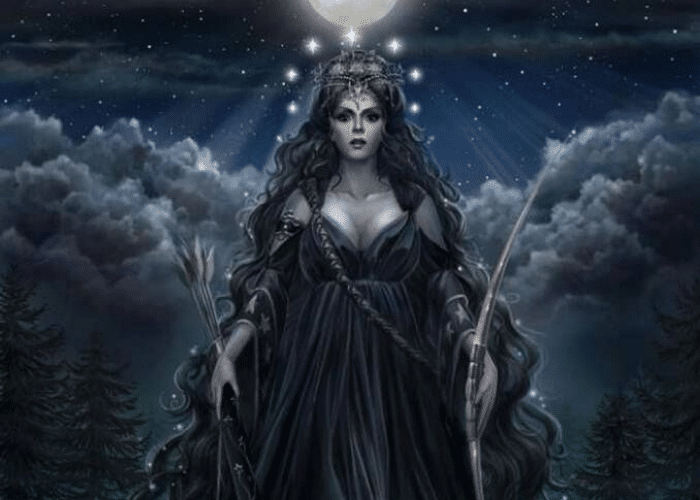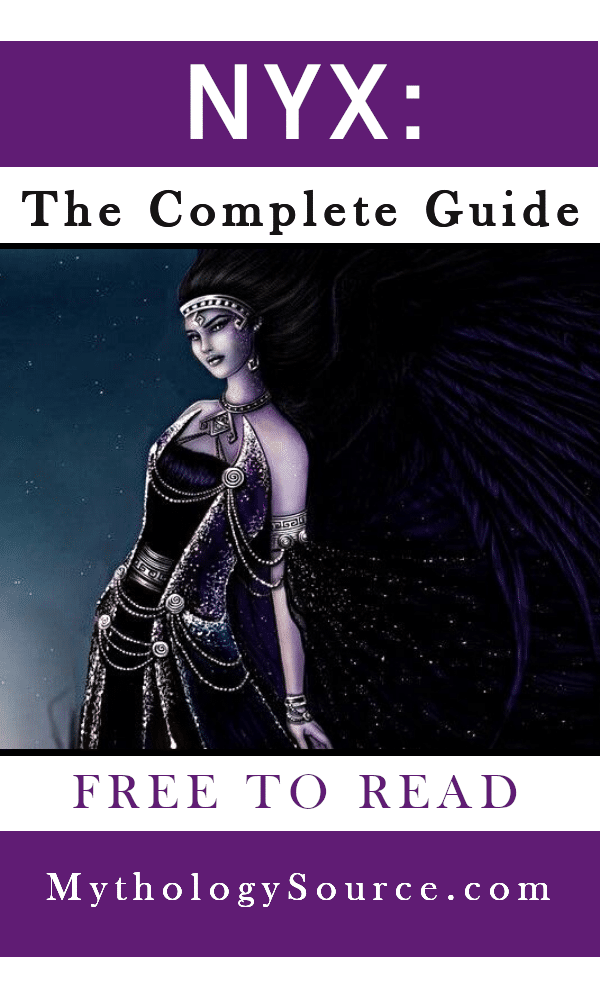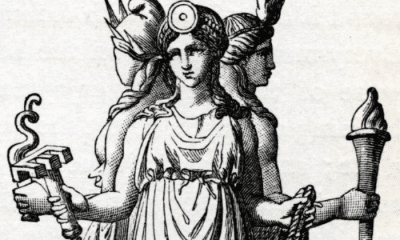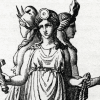
Greek
Nyx: The Goddess of the Night
Nyx: The Goddess of the Night
A dark goddess to be both feared and loved, here is everything you need to know about Nyx, the primordial goddess of the night!
In the Greek creation story, one of the first elements to come into being was the night. Represented as the goddess Nyx, it was one of the primordial elements from which everything else, including the gods, was created.
Nyx was so central in the Greek idea of the universe that she came before the day or even light. Some cults even believed she was so important that she had given rise to everything in the universe, including the earth itself.
Nyx was a goddess that could inspire great fear, like the fearful aspects of the night time she represented. As the mother of many ills and the consort of darkness, even Zeus knew better than to cross Nyx.
But she could also be a source of love, comfort, and rest. For many people, Nyx was a benevolent goddess.
Keep reading to find out how the Greeks viewed the night, and the goddess that embodied it!
Nyx at the Dawn of Time
Nyx was one of the primordial deities who emerged at the very beginning of the universe. According to most legends, she was born from Chaos itself, making her a sister of major primordial gods like Gaia and Tartarus.
These primordial gods represented the very foundations of the universe. All subsequent life and material came from them.
Nyx was the goddess of night. She did not just rule over the night, she was the embodiment of night itself.
Like the rest of the primordial gods, this meant that she had no form and little characterization beyond this element. While she was sometimes depicted as a woman en-robed in dark mists, she was understood to be the night itself.
Often, the mists of the night were represented by a black cloak that arched above her, particularly in sculpture. She was occasionally shown with wings to fly across the dark sky, but more often was pulled by a chariot.
The chariot moving across the sky was a common element of ancient cosmology, and one she shared with the sun god Helios and his lunar sister Selene. Nyx, however, had a chariot of black that was pulled by either a team of black horses or a pair of black bulls.
The Goddess of Night
As the goddess of night, Nyx was often paired with Erebus, the embodiment of darkness. Both had emerged from Chaos and were closely related.
Erebus was the god of all darkness, from the murky realms of the edge of the world to the underground places sunlight could not reach. He accompanied his sister and consort, Nyx, as she moved across the sky.
The sky, Uranus, was a great dome of brass that arched over the earth. He would not have a blue color until the Titaness Theia took her place.
He also would not be touched by daylight. In the beginning only Erebus and Nyx drove a dark chariot across Uranus. Their children, Hemera (Day) and Aether (Brightness) would be the first to illuminate both Uranus and the surface of Gaia.
Her children became her opposites, balancing the powers of their mother and father. While Nyx moved across the sky at night, Hemera ruled it by day.
According to Hesiod, the two shared a home at the edges of the world. They greeted each other at the door in the morning and at twilight, but never shared the house at the same time.
Nyx and Mysteries
As the goddess of night and the consort of darkness, Nyx had an obvious place within the mystery cults of Greek religion.
There were no known temples of Nyx. Like most of the primordial beings, she was considered both too incorporeal and too unlike humans to have little care over what they did.
There are cult images and small shrines dedicated to Nyx, however. She often featured in the background of worship of other deities like Artemis or Hecate.
It is unsurprising that Nyx was closely linked to Hecate, the goddess of magic and witchcraft. Practitioners of magic were thought to be most powerful in the dark and could only perform many of their spells under the night sky.
Descriptions of magic, particularly witchcraft, in the ancient world often included a call to Nyx.
She did not only have an important place in the lore of witchcraft, however. Nyx also played an important role in the Orphic mysteries. Share on XShe [the witch Kirke (Circe)] sprinkled round about her evil drugs and poisonous essences, and out of Erebos and Chaos called Nox (Nyx) and the Gods of Night (Di Nocti) and poured a prayer with long-drawn wailing cries to Hecate. The woods (wonder of wonders!) leapt away, a groan came from the ground, the bushes blanched, the spattered sward was soaked with gouts of blood, stones brayed and bellowed, dogs began to bark, black snakes swarmed on the soil and ghostly shapes of silent spirits floated through the air.
-Ovid, Metamorphoses 10. 403 ff (trans. Melville)
These cults had a cosmology and worldview that often differed from that of mainstream Greek religion. As part of their efforts to understand the secrets of death and the nature of the afterlife, they prioritized deities who were associated with those realms.
Because of their focus on chthonic deities and the secrets of the dead, the Orphic cults often revered gods and goddesses with darker aspects than the rest of the Greek pantheon. While other Greeks preferred gods of light like Apollo, the Orphic mysteries prayed to Persephone as the queen of the underworld and Hecate as the keeper of secret magic.
The goddess of night and consort of darkness was, therefore, of great interest to those who followed the Orphic rites.
Those initiated into the Orphic mysteries learned that Nyx, rather than Chaos, was the primordial form from which all other life and matter was born. All things began in the night.
Unlike the more traditional view that Eros, the personification of love, was the son of Aphrodite, the Orphic mysteries believed that he had been one of the first children of Nyx. Love, specifically romantic and sexual love, had existed before even Gaia came into being.
Believers in the mystery cults also thought that Nyx could be reached by those who sought to learn more about the world. Instead of relying on the divine oracles of Apollo, a god of the day and sunlight, they believed that at the far reaches of the world Nyx occupied a cave from which she gave more accurate prophesies than any other god was capable of.
The Orphic mystery cults did not represent the common view of cosmology and the divine hierarchy of Greek mythology, but they ended up having an influence nonetheless. The idea of Nyx as a prophetic goddess and the mother of Eros sometimes crept into more mainstream writings as well as the poems and hymns of the Orphic cults.
Mother of Gods and Spirits
While the Orphic mysteries were unique in holding Nyx as the origin of all life, even mainstream Greek religious thought believed she had an important role as a mother.
Her most important children, Aether and Hemera, were born from her union with Erebus. Darkness and Night gave rise to their opposites, Brightness and Day, in one of the first dualities of cosmic balance that would become important in Greek philosophy.
Nyx had many other children as well. While a few were fathered by Erebus, others she gave birth to of her own accord. Share on XIt is probably not a surprise that most of her children, especially those born without the assistance of Erebus, were associated with the night. Like most gods, Nyx tended to have children that reflected more specific aspects of her own broad domain.
These included:
- Hypnos – The personification of sleep. He lived in his father’s land, Erebus, at the edge of the world but came out each night as part of his mother’s retinue.
- The Oneiroi – Also denizens of Erebus, the Oneiroi were the personifications of dreams. Numbering in the thousands, they were sometimes described as children of Hypnos instead.
- Thanatos – Usually considered a twin of Hypnos, Thanatos was the personification of death. He specifically represented a peaceful and painless death that was closer to his twin’s domain than a violent end.
- Momos – Momos was also a personification of death. Unlike Thanatos, he embodied a violent or sudden end and was often accompanied by pain and fear.
- Moros – Moros represented doom and the forces that drove man toward either Thanatos or Momos. He was often associated with the Moirai, the Fates.
- The Moirai – There was no agreement over the parentage of the Fates. Even Hesiod called them both daughters of Nyx and of Themis. Nyx was a commonly given mother, however.
- The Keres – Sometimes a singular goddess, Ker, they were the personifications of the necessity of death. They were often shown on battlefields where they were fearsome but inescapable spirits.
- Nemesis – The goddess of resentment, she took retribution against those who gained undeserved wealth, had an excess of good fortune, or committed crimes without punishment.
- Philotes – She was the personification of affection and friendship. Her name could also be used as a term for sexual intercourse, which happened under her mother’s power.
- Apate – The personification of deception and fraud, she often worked at night.
- Eris – The goddess of strife and discord was named by Homer as a child of Zeus, but other sources said she was a child of Nyx and Erebus.
- Geras – The spirit of old age, he was usually depicted as a frail and withered man.
- Oizys – One of the most malevolent children of Nyx, she was the embodiment of misery and suffering.
- The Erinyes – According to Aeschylus and Virgil, the Furies were the daughters of night.
Like most ancient cultures, the Greeks believed that the darkness of night brought a variety of evils out. While Nyx was not the mother of terrible monsters, she was the origin of many of the day to day woes that plagued the Greek people.
Many of the children of Nyx were unwelcome but unavoidable. The various forms of death, suffering, old age, and other unhappy parts of life were dark and dangerous but as inescapable as the will of the Fates.
Fearsome Nyx
Many of the primordial deities faded into the background when their role in the creation of the universe had ended. Tartarus, for example, remained an important place but was rarely regarded as a character.
A few, however, continued to occasionally feature in the stories of the Olympians. While Gaia is the more notable of these, Nyx also made appearances in later legends.
When she did, she was depicted as a goddess to be feared and respected, even by the king of the gods himself.
For example, one episode of the Iliad showed that at one point Nyx kept Zeus himself from having justice.
Hera had once asked Hypnos to put Zeus to sleep so that she could interfere with her hated stepson, Heracles. When Zeus awoke and realized what had happened, he was so furious that he threatened to kill Hypnos.
Zeus raged, beating other gods within his household and searching everywhere for the god of sleep. Nyx, however, took her son in to protect him.
Although he was the king of the gods and consumed by fury, Zeus stopped going against Hypnos. According to Homer, he was so in awe of the goddess of the night that he did not dare to move against her and risk her own anger.
The goddess of the night was rarely depicted in mythology, but when she was, she was seen as such a powerful being that even Zeus himself was afraid to cross her.
A Goddess of Calm and of Danger
Although she was the mother of many evils and so fearsome that even Zeus would not move against her, Nyx was also regarded as a source of comfort.
Like the night time she represented, Nyx could be very dangerous but could also be peaceful and beautiful. Share on XShe could be helpful as well. By night, for example, sailors could see the stars they used to navigate.
In the play Agamemnon, the Greek troops thank Nyx for helping them win the Trojan War. The darkness and stillness of night allowed them to sneak into the city, ending a ten-year siege.
Common people, according to one Roman source, welcomed Nox, as she was called in Latin. The coming of night meant an end to a long day of toil and well-deserved rest at home.
Nyx was occasionally helpful to the gods, as well. When Eos, the goddess of the dawn, lost her human son in battle Nyx prematurely came over the earth so his body could be safely retrieved in darkness.
The Orphic hymns, which held her in high regard as the source of all life, thanked Nyx for bringing calm and rest to the word. While the night could be feared, it could also be welcomed for its stillness and the arrival of prophetic and beautiful dreams.
The Goddess Nyx
Nyx was the primordial goddess of the night in Greek mythology. She was the consort of Erebus, the primordial darkness.
Most versions of the Greek creation myth claim that Nyx was one of the first children of Chaos, born at about the same time as Gaia and Tartarus. The Orphic mystery cults, however, believed that she had been the original being in the universe and all other creation had begun with Nyx.
Nyx and Erebus gave rise to their opposites, Hemera and Aether, creating one of the first pairings of opposites that created balance and order in the cosmos.
She was also the mother of many other divine children. While a few, like the god of sleep Hypnos, were benevolent, many more represented the evils and miseries that plagued mankind.
Nyx was a powerful being. She could be so fearsome that even Zeus did not dare to upset her when she took one of her children under her protection.
She could also be a calm and kind goddess, though. While many specific actions were only possible at night, people as a whole had reason to thank her for providing a time of rest at the end of a long day of toil.




